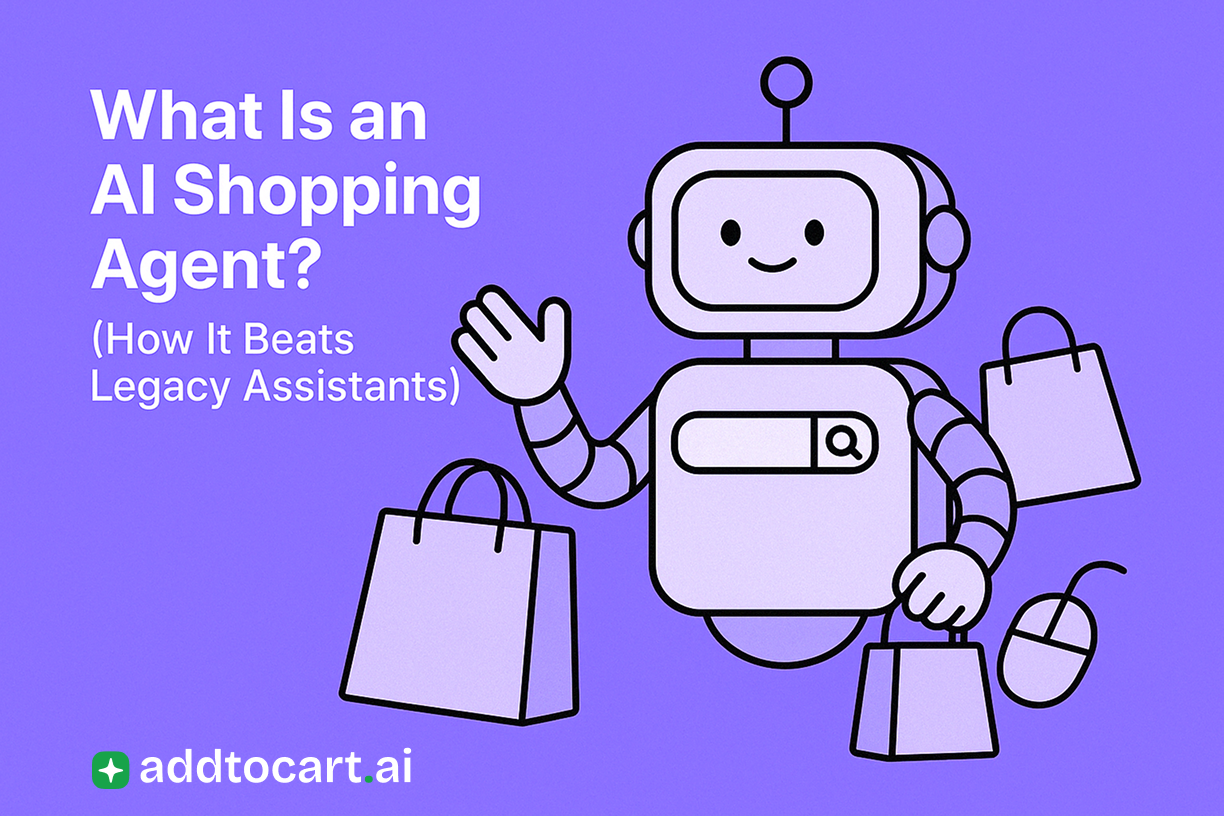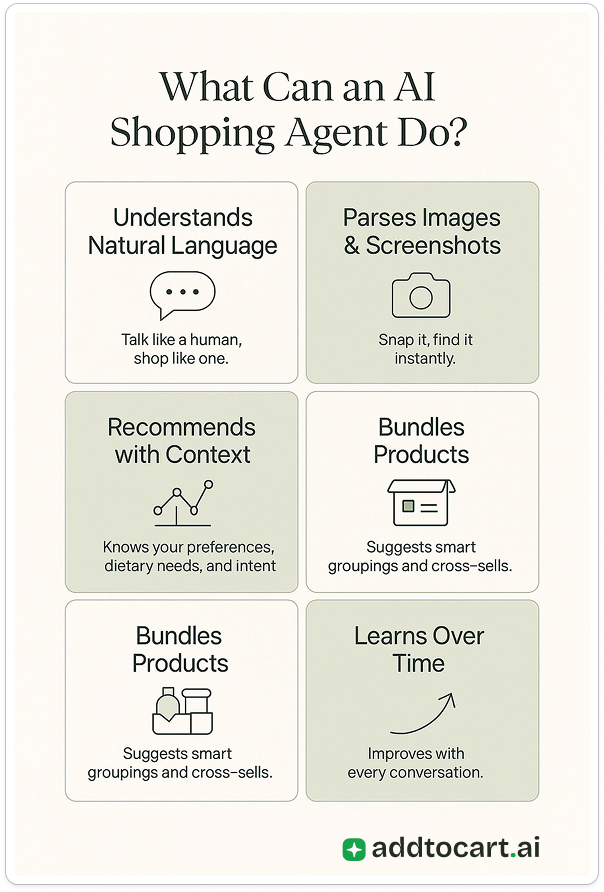What Is an AI Shopping Agent? (How It Beats Legacy Assistants)

What Is an AI Shopping Agent? (How It Beats Legacy Assistants)
TL;DR: From pasting a 25-item grocery list to hitting “Checkout” in less than ten seconds—AI Shopping Agents are rewriting the rules of e-commerce.
Online shopping is convenient, but far from perfect. Complicated checkouts, confusing menus, and unhelpful chatbots often lead to frustration and abandoned carts. Scrolling through category pages is the e-commerce equivalent of pushing a squeaky cart down endless aisles. It’s part of the reason ~70 % of online carts are abandoned worldwide.
An AI Shopping Agent changes that experience. Imagine simply typing or speaking your shopping list and having your cart instantly prepared for checkout. A shopper in your store simply asks, and the AI shopping agent works to gather the requested items without manual clicks or scrolls, all in record time compared to the old, time-consuming online shopping method we are accustomed to. This seamless experience is exactly what an AI Shopping Agent delivers.
What Exactly Is an AI Shopping Agent?
Definition: An AI Shopping Agent is an autonomous, multimodal AI system that can understand natural-language or visual or voice input, compile product data in real time, and complete purchase flows on the shopper’s behalf.

One prompt. Full cart. Zero friction. Experience AI-assisted shopping that skips the scroll.
In other words, an AI Shopping Agent is advanced software designed to improve online shopping by handling tasks that traditional chatbots and virtual assistants simply can’t. Rather than merely answering basic questions, these AI-powered agents understand detailed requests, remember customer preferences, and autonomously build personalized carts for immediate checkout.
To draw a quick comparison: a typical e-commerce chatbot might be able to tell you “Our store hours are 9 am–5 pm” or “Your order is on the way.” An AI shopping agent, on the other hand, aims to handle far more complex requests.
Ask it, “I need a birthday gift for my mom, she loves gardening and I have a $50 budget,” and a well-designed agent could quickly scan dozens of products, ask a follow-up question if needed (“Would you like something decorative or practical for the garden?”), then present you with a few curated options. In short, AI shopping agents combine the natural conversation of a helpful salesperson with the efficiency of automation.
AI Shopping Agent Features
AI Shopping agents can bring some of the following features to retailers’ websites:
- Understands natural-language requests (“Show me gluten-free pasta under $10”) or visual inputs (snap a pantry shelf photo).
- Selects relevant products in real time by querying your live catalog.
- Assembles a full cart—applying coupons, selecting variants, and filling shipping.
- Learns from every conversation to optimize future recommendations.
Why AI Shopping Agents Are Better than Legacy “Assistants”
Despite improvements in user experience, online stores continue to lose conversions. Traditional chatbots and assistants often fail because they provide generic and scripted responses. They cannot handle complex customer needs and stop short of completing purchases. Finally, traditional assistant chatbots lack the agentic actions that truly help shoppers save time, like adding items to the cart. In contrast, AI shopping agents are designed to tackle these specific challenges head-on.
| Area | Legacy Assistant | AI Shopping Agent |
|---|---|---|
| Inputs | Text only | Text, image, voice |
| Output | Product links | Ready-to-buy cart |
| Personalization | Session-based | Persistent profiles |
| AOV Impact | +3–5 % | +20–30 % (case studies) |
| Merchant ROI | CX uplift | Direct revenue lift |
The Evolution: From Chatbots to AI Agents
To appreciate why AI shopping agents are a big deal, it helps to look at how we got here. Over the past decade, retailers and tech companies have experimented with various “digital helpers,” each with its limitations. The technology behind shopping agents has evolved rapidly:

We went from chatbots that waited for you and were often disappointing, to voice assistants that listened to you but had limited abilities, to AI shopping agents that can collaborate with you.
Advances in multimodal AI models, which parse text, images, and structured feeds, make AI shopping agents possible today.
Each step was driven by technological leaps. First, basic automation, then voice recognition, and now advanced AI that understands language and goals. The result is a fundamentally different experience.
AI Shopping Agents Capabilities

Modern AI shopping agents significantly outperform legacy tools. They offer several core capabilities that improve the shopping journey for retailers’ websites. Some of these improvements are:
- Conversational Cart-Building & Multimodal Understanding: They interpret user input via text, images, and voice, enabling users to shop conveniently in their preferred style. Paste a bulk list → cart auto-populates (zero filter clicks).
- Autonomous Cart Creation Agents proactively assemble carts based on user requests, such as “I need a gluten-free gift basket under $50,” significantly speeding up the buying.
- Context-Aware, Personalized Recommendations By considering user preferences, agents offer tailored product suggestions, enhancing customer satisfaction and driving higher sales conversions—up to 82 % improvement in some cases (Juniper Research, 2024).
Impact on Merchants and Shoppers
A technology can be clever, but it needs to deliver real value. AI shopping agents appear poised to do just that, creating a win-win for both consumers and retailers. Here’s how they are making an impact:
Shopper Wins: A Personalized, Friction-free Experience
- Speed & Convenience: Turn lists into carts in 5 seconds.
- Personalization: Tailored suggestions—dietary, style, past behavior.
- Frustration Reduction: Instant, relevant help at every critical moment.
- Project Concierge: Multi-item bundles, compatibility checks, meal plans—all in one chat.
Merchant Wins: Higher Conversions, Loyalty, and Insights (Why CFOs Care)
- Higher Conversions: Real-time assistance reduces abandonment.
- AOV Uplift: Personal recommendations can boost order totals by 8–32 %.
- First-Party Insights: Every interaction yields data to refine marketing and inventory.
- Operational Efficiency: Scale routine support and free teams to handle complex queries.
A better checkout design alone could recover an estimated $260 billion worth of lost orders in the US and EU—AI Shopping Agents offer that and more.
Real-World Examples and Case Studies
- Perplexity rolled out its shopping agent in late 2024, letting users open a chat, request a product, and watch as the AI browses multiple sites, secures the best match, and checks out using single-use Stripe cards.
- Google & OpenAI are said to be building assistants that can book flights or order goods on command.
- Amazon is eyeing upgrades to Alexa and its “Rufus” chatbot.
- At NRF 2025, both Nvidia and Amazon unveiled toolkits and data frameworks for retailers to craft their own shopping AIs.
- Bluecore’s acquisition of Alby brought a guided, click-based agent onto retail sites—customers answer simple questions to narrow thousands of options, and the AI instantly tailors suggestions.
- In Asia, brands on WhatsApp and Messenger are deploying end-to-end AI assistants. Global retail spend via chat apps is projected to reach $43 billion by 2028.
Getting Started with AI Shopping Agents
Implementing an AI Shopping Agent like Add To Cart AI into your e-commerce website is straightforward:
- Installation: Easily integrate the Add To Cart AI plugin with WooCommerce (Shopify and Magento coming soon).
- Data Integration: Upload your product catalog and set custom interaction rules.
- Launch & Optimize: Begin using immediate AI features to enhance your store’s performance and customer experience, increasing conversations and sales.
Future-Proof Your Store
AI Shopping Agents represent the next major shift in digital commerce, transforming the shopper experience into something quick, intuitive, and enjoyable. With rapid growth projected for conversational and voice commerce (estimated to reach $186 billion by 2030), retailers adopting AI shopping agents today will lead tomorrow’s market.
Ready to see an AI Shopping Agent in action? Book a 15-minute demo with Add To Cart AI at addtocart.ai or email [email protected].
